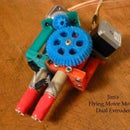Introduction: Surprise Picture Card
The little gif shows the Surprise; the video shows more fully the Surprise Picture in action. The transformation of one picture into another by simply pulling a slider is almost magical! This Instructable will show you how to create a Surprise Picture card using your own pictures. Create a custom card for any occasion. Amaze and amuse yourself and your friends.
The Surprise Picture, or “Dissolving Scene”, mechanism has been known for well over a century. But it has been difficult to create due to the precision of the cuts required. Now, using the “print to cut” feature of the Silhouette cutters, it’s easy! With the design provided in this Instructable, you can to create your own unique Surprise Picture cards. All you need is a printer and a Silhouette cutter.
Prerequisites: You will need access to a Silhouette Cameo cutter. (This could be adapted to the smaller Silhouette Portrait if you are ambitious.) Some familiarity with Silhouette Studio is assumed. Version 3.8 (precisely: 3.8.19ss) is used in this Instructable. This shouldn’t be your first project! You’ll also need access to a color printer that can print onto Letter size cardstock. Inkscape is useful but not required for creating the outer cover for the card.
The card is made of two parts: a Cover and a Slider. You’ll learn how to make them both – and combine them into a card. Let’s get started!
Step 1: Creating the Cover
The Cover is the part of the card that covers the Slider and that people see first. Opening it reveals the window through which the pictures are viewed. Placement of the text (or whatever) on the cover is probably best done in Inkscape or a similar tool. Using Inkscape, you can open the TigerCard.svg file. Whatever text or image you want on the cover is put in the lower half of the sheet, right side up (not inverted). The Silhouette “print to cut feature” is not necessary here since high precision is not required. The TigerCard.pdf file is the file I printed for my version. You should print your version on cardstock now.
Attachments
Step 2: Cutting the Window in the Cover
The Silhouette Cameo will be used to cut the window in the Cover. The window for the Slider is in the lower half of the Cover and a notch for the pull tab is provided. I’ve done this part for you and you can just use my version unless you want to change the size or location of the window. Just load the TigerCover.studio3 file and use it to make the cuts for the Cover. After your cover is printed, place it face down with the printing nearest the leading edge of the cut mat (it will be upside down). The leading edge is the edge that goes into the cutter first. See the picture. Send the file to the Silhouette to do the cutting.
Attachments
Step 3: Creating the Slider
The Slider is the interwoven combination of two images that slide to reveal the surprise picture. It’s the heart of this card. To create the slider, begin by loading the SliderTiger.studio3 file into the Silhouette Studio software. The picture above shows how the Slider appears in the software. If you’re new to using “print to cut”, the display may look a little strange. This is how a “print to cut” project looks.
Replace the images with your own. Use the capabilities of the software to size your images to match the ones I used and replace mine. Try to position your images in the same places so the dissolve will work right. Once you make one of these, it’s easy to experiment with the placement and sizing of the images to suit your own desires. Save your work and print it out on cardstock. Position the print onto the cut mat as shown in the other picture and cut it on the Cameo.
The “print to cut” feature works by placing three alignment marks (the square and two angles) onto the sheet you will print. These marks are detected by the Cameo and allow it to precisely position the cuts it makes. Note that the gray cross-hatched areas are keep-out zones: do not put any of your graphics in these areas or they will interfere with the alignment process.
After cutting, remove the two pieces of your Slider carefully without curling or tearing it and be sure all the cuts are clean and open. Any snags will keep it from moving smoothly.
Pro tip: If you use photo glossy paper for your Slider, the Cameo will have trouble locating the alignment marks because the light reflects strongly from the photo paper. Use some fine sandpaper (400 grit works great) to roughen the area around the alignments marks a bit and Bob’s you’re uncle!
Step 4: Assemble the Slider
The video shows how to interleave the two pictures. The top edge of the rear picture can be folded before or after interleaving; I find it easiest to do it before. Position the front picture (the Kitten in the example) in front. Hold the two pieces together and turn them over. Interleave the tabs from the back picture through the slits in the front picture. After interleaving, slide the upper picture so it won’t interfere with gluing the tabs to the top edge.
Step 5: Glue the Slider
The first video shows how to mask and glue the picture tabs to the top edge. Glue just the right hand 3/8” of the top edge as well. Avoid getting any glue anywhere else on the top edge. For best results, let this dry before proceeding.
The second video shows how to position slider and put the notch into the slot. Fold and glue the bottom edge. Use a strip of paper to avoid getting glue everywhere. Next fold and glue the tab. The Slider is done.
Step 6: Assemble the Card
The final step is to position the Slider in the window of the Cover and tape it in place. See the photo above. Enjoy sharing the Surprise Picture card with your friends!
Step 7: Bonus! How the Cuts Were Created
Fortunately, I have done this part for you! All you need to do is replace my text and images with your own. Print your design on card stock, load it into the Cameo, and cut it out. That’s what this Instructable has been all about! But for those who might want to create their own custom cuts, here are some useful details.
The design for the cuts was first created as two single line curves using FreeCAD and exported as an svg. Using Inkscape, each svg file was first imported, then exported as a png file which could be imported into Silhouette Studio. After import, the Trace Tool was used. This created a line completely around the curve, effectively resulting in a double line. This is unsuitable, but easy to fix. Zoom way in until the double line is visible and use the Eraser tool to remove the very tips of the lines (where they join). Ungroup the two lines and delete one of them. Then the remaining line can be duplicated as desired. Use the Arrange tool to distribute the lines evenly.
Reference: The “dissolving scene” design is discussed in Paper Engineering for Pop-up Books and Cards by Mark Hiner. The angles and dimensions he suggests are used for the design in this Instructable.
Using the “print to cut” feature is explained in the The Ultimate Silhouette Guide ebook, which I highly recommend. There are also numerous on-line tutorials about this feature.

Participated in the
Papercraft Contest 2017















